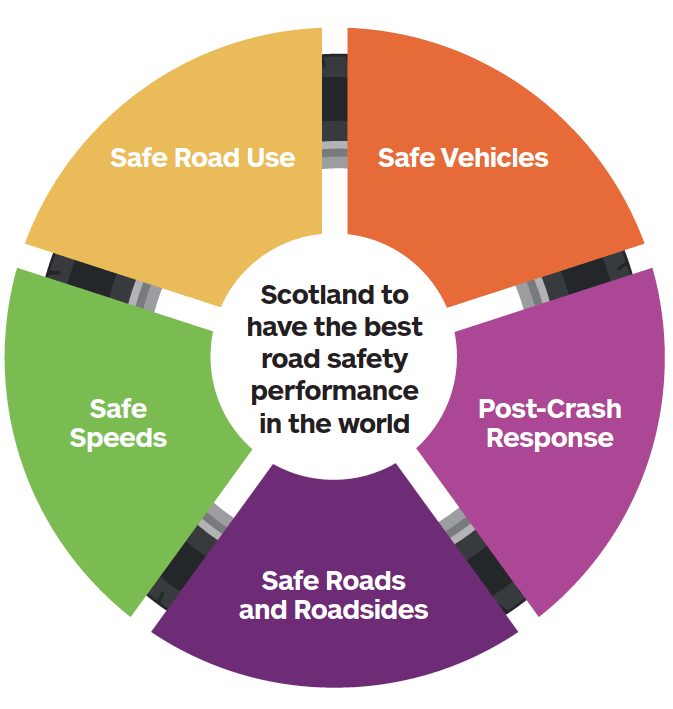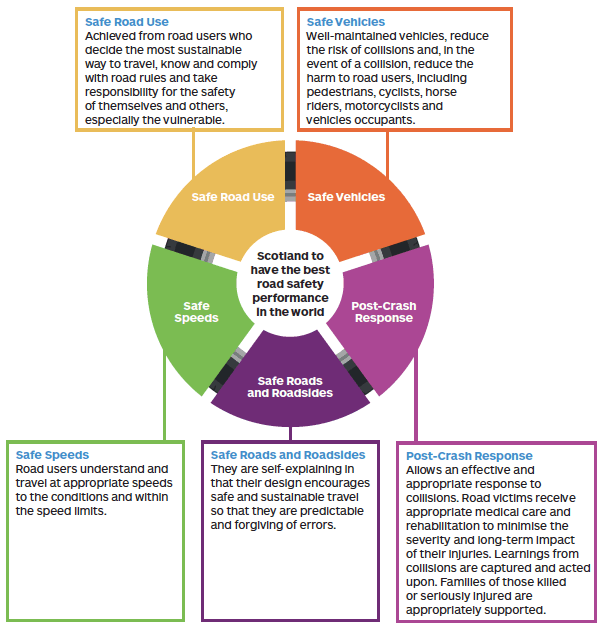A Vision for Scotland
Scotland’s Road Safety Framework to 2030
A Vision for Scotland
Our vision is for Scotland to have the best road safety performance in the world by 2030.
It is unacceptable and unethical that anyone is killed or seriously injured on our roads; any road users must be free from road traffic harm as much as they are free to drive/ride/walk/travel.[7] This framework identifies the part every one of us has to play in ensuring our long-term aspiration for Vision Zero to become a reality. It builds on the approach and actions set out in the first framework "Go Safe on Scotland's Roads – It's Everyone's Responsibility", published in 2009 and recognises the significant contribution made to meeting the 2020 casualty reduction targets. Drawing on the latest evidence, it reflects recent successes, highlights key challenges for the immediate and longer-term, and sets out new, ambitious targets, key performance indicators, and strategic actions for the next decade. This will help shape our collective efforts, inspire collaboration and frame a shared vision for the future.
The framework embeds the Safe System approach to road safety delivery as set out in the NTS2 Delivery Plan. This is international best practice (see Figure 2 below). It sets out an ambitious approach to road safety management based on well-established safety and organisational principles. It is a synthesis of current knowledge about how to effectively manage for better results, and builds on best practice using innovative solutions and new technologies. The Safe System comprises both an explicit goal and a strategy by which it can be delivered.
- The explicit, longer-term goal of the Safe System is for a road traffic system which becomes free from death and serious injury through incremental, targeted improvements within a specified safety performance framework. It is backed up by interim, quantitative targets to reduce numbers of deaths and serious injuries – usually measured over a ten-year period. There is also a focus on targeting those intermediate outcomes which are causally-related to death and serious injury, such as: average speeds; seatbelt use; sober driving; the safety and quality of roads and vehicles; and emergency medical system response. It involves an important paradigm shift away from trying to prevent all collisions towards preventing death and mitigating serious injury in collisions, a problem which is largely achievable based on current knowledge.
- The strategy puts people at its centre, and aims for a more forgiving road system that takes human vulnerability and fallibility into account; people are fragile and make mistakes that can lead to collisions. A Safe (road) System mitigates that problem with its five pillars which effectively act as layers of protection: safe road use; safe roads and roadsides; safe vehicles; safe speeds; and better post-crash response; all working in harmony to prevent deaths and serious injuries.
The holistic approach of the Safe System creates the conditions for road casualties not to occur by focusing efforts not only on road traffic casualty reduction (vulnerability of the casualties) but also on road traffic danger reduction (sources of the danger).[8]
Road safety is defined as any policy, project, plan, programme or strategy which aims to reduce the number and severity of road traffic casualties or reduces road danger with better education or through the design, building, operation or use of the road system.
Figure 2: Safe System approach to road safety

A Safe System involves those who manage and design the roads as well as those who use them; each is responsible for, and must contribute to, eradicating fatal and serious injuries. Ultimately,
all road users are expected to use the roads safely and comply with the rules. To help achieve our vision, the framework identifies five outcomes (Safe Road Use, Safe Roads & Roadsides, Safe Speeds, Safe Vehicles and Post-crash Response) which describe the road safety environment it aims to deliver. These outcomes align with the
five pillars of the Safe System (see Fig 3 below)
Figure 3: five pillars of the Safe System

Safe Road Use
Safe road users are competent at all levels, including: paying full attention to the road ahead and the task in hand; adapting to the conditions (weather, the presence of other users, etc.); travelling at lower speeds; not driving while impaired through drink, drugs (including medicines) or fatigue; not being distracted by in-vehicle technology (mobile phones, entertainment systems, sat navs, etc.); and giving sufficient room to all other road users, no matter what their mode of travel. Safe road users are mindful of the hierarchy of road users, which ensures that those road users who can do the greatest harm have the greatest responsibility to reduce the danger or threat they may pose to others. They respect other road users at all times and assume responsibility for others' safety as well as their own.
Measures to encourage safe road use also include working together to reduce car-based traffic, inspiring people to use active modes, such as walking, wheeling or cycling or to use public transport rather than their own vehicles.
Education interventions are also important to ensure road users are risk-aware, can develop coping strategies for high-risk situations, and act appropriately to keep themselves and others safe on the road.
Safe Roads and Roadsides
In a Safe System, roads and roadsides are designed to reduce the risk of collision, and to mitigate the severity of injury should a collision occur. A combination of the design and maintenance supported by the implementation of a range of strategies to ensure that roads and roadsides can be as safe as possible can reduce casualties on our roads. One way in which this can be achieved is to both segregate different kinds of road users and the traffic moving in different directions or at different speeds. If this is not possible, promoting positive behaviours and safer sharing of spaces, as well as the appropriate use of speed limits and signage, can also be a much more affordable and sustainable way to protect the most vulnerable road users.
Safe Speeds
Speed limits in a Safe System are based on
aiding crash-avoidance and reducing the speed
at which impacts occur. This ensures the body's limit for physical trauma is not reached or exceeded. The Safe System aims to establish appropriate speed limits according to the features of the road, the function it serves, and the physical tolerance of those who use it.
The key factors that should be taken into account in any decisions on local speed limits are:
- history of collisions
- road geometry and engineering
- road function
- composition of road users (including existing and potential levels of vulnerable road users)
- existing traffic speeds
- road environment
Safe Vehicles
Vehicles are designed and regulated to minimise the occurrence and consequences of collisions to road users. This applies not only to vehicle occupants, but also to pedestrians, cyclists,
horse-riders and motorcyclists. Making vehicles safer involves both 'active' safety measures, such
as autonomous emergency braking, which can prevent collisions occurring in the first place,
and 'passive' safety measures, such as seatbelts and airbags, which protect occupants (and other road users) if a collision does occur. It is also vital to ensure vehicle roadworthiness is regulated to the highest standards. Technology within vehicles, such as feedback from the speedometer and seatbelt reminders can also educate road users about safe road use.
Increasingly, roads and vehicles will be managed within an intelligent transport system, relying on ever-more autonomous vehicles and smart infrastructure. As safety becomes hardwired
into vehicle technology and road design, there
is potential to further reduce road casualties
and deaths through this route.
Post-crash response
It is vital to work with the emergency services
and the National Health Service (NHS) to enable the best possible response to collisions, ensure victims are effectively cared for, and facilitate meaningful investigations into the causes and potential solutions for the future. Health outcomes for victims rely on the ability of the system to quickly locate and provide emergency first responder care, in order to stabilise victims
and transport them to hospital for further specialist treatment.